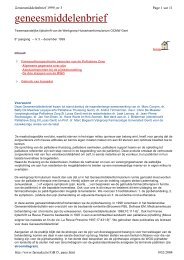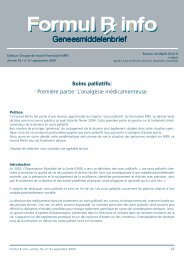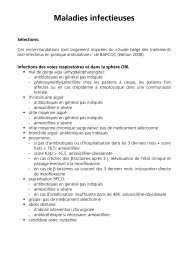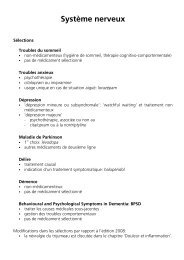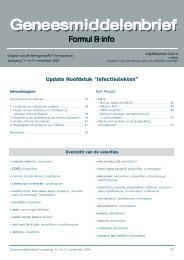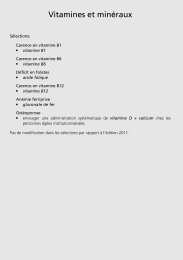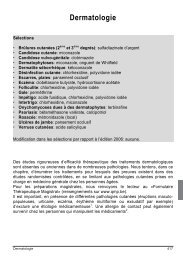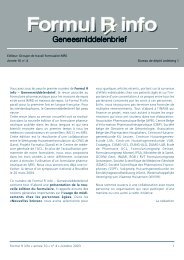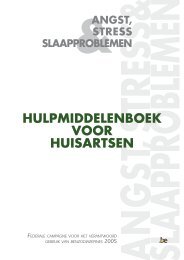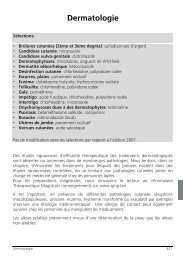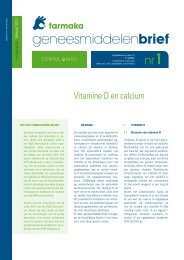Beers Criteria Printable Pocketcard - American Geriatrics Society
Beers Criteria Printable Pocketcard - American Geriatrics Society
Beers Criteria Printable Pocketcard - American Geriatrics Society
You also want an ePaper? Increase the reach of your titles
YUMPU automatically turns print PDFs into web optimized ePapers that Google loves.
AGS BEERS CRITERIAFOR POTENTIALLY INAPPROPRIATEMEDICATION USE IN OLDER ADULTSFROM THE AMERICAN GERIATRICS SOCIETYThis clinical tool, based on The AGS 2012 Updated <strong>Beers</strong> <strong>Criteria</strong> for Potentially Inappropriate Medication Use in OlderAdults (AGS 2012 <strong>Beers</strong> <strong>Criteria</strong>), has been developed to assist healthcare providers in improving medication safety inolder adults. Our purpose is to inform clinical decision-making concerning the prescribing of medications for olderadults in order to improve safety and quality of care.Originally conceived of in 1991 by the late Mark <strong>Beers</strong>, MD, a geriatrician, the <strong>Beers</strong> <strong>Criteria</strong> catalogues medicationsthat cause adverse drug events in older adults due to their pharmacologic properties and the physiologic changes ofaging. In 2011, the AGS undertook an update of the criteria, assembling a team of experts and funding the developmentof the AGS 2012 <strong>Beers</strong> <strong>Criteria</strong> using an enhanced, evidence-based methodology. Each criterion is rated (qualityof evidence and strength of evidence) using the <strong>American</strong> College of Physicians’ Guideline Grading System, whichis based on the GRADE scheme developed by Guyatt et al.The full document together with accompanying resources can be viewed online at www.americangeriatrics.org.INTENDED USEThe goal of this clinical tool is to improve care of older adults by reducing their exposure to Potentially InappropriateMedications (PIMs).n This should be viewed as a guide for identifying medications for which the risks of use in older adults outweighthe benefits.n These criteria are not meant to be applied in a punitive manner.n This list is not meant to supersede clinical judgment or an individual patient’s values and needs. Prescribing andmanaging disease conditions should be individualized and involve shared decision-making.n These criteria also underscore the importance of using a team approach to prescribing and the use of nonpharmacologicalapproaches and of having economic and organizational incentives for this type of model.n Implicit criteria such as the STOPP/START criteria and Medication Appropriateness Index should be used ina complementary manner with the 2012 AGS <strong>Beers</strong> <strong>Criteria</strong> to guide clinicians in making decisions about safemedication use in older adults.The criteria are not applicable in all circumstances (eg, patient’s receiving palliative and hospice care). If a clinician isnot able to find an alternative and chooses to continue to use a drug on this list in an individual patient, designationof the medication as potentially inappropriate can serve as a reminder for close monitoring so that the potential foran adverse drug effect can be incorporated into the medical record and prevented or detected early.TABLE 1: 2012 AGS <strong>Beers</strong> <strong>Criteria</strong> for Potentially Inappropriate Medication Use in Older AdultsOrgan System/Therapeutic Category/Drug(s)Anticholinergics (excludes TCAs)First-generation antihistamines (as singleagent or as part of combination products)n Brompheniraminen Carbinoxaminen Chlorpheniraminen Clemastinen Cyproheptadinen Dexbrompheniraminen Dexchlorpheniraminen Diphenhydramine (oral)n Doxylaminen Hydroxyzinen Promethazinen TriprolidineAntiparkinson agentsn Benztropine (oral)n TrihexyphenidylAvoid.Recommendation, Rationale,Quality of Evidence (QE) & Strength of Recommendation (SR)Highly anticholinergic; clearance reduced with advanced age, andtolerance develops when used as hypnotic; increased risk of confusion,dry mouth, constipation, and other anticholinergic effects/toxicity.Use of diphenhydramine in special situations such as acute treatmentof severe allergic reaction may be appropriate.QE = High (Hydroxyzine and Promethazine), Moderate (All others); SR= StrongAvoid.Not recommended for prevention of extrapyramidal symptomswith antipsychotics; more effective agents available for treatment ofParkinson disease.QE = Moderate; SR = StrongTable 1 (continued from page 1)TABLE 1: 2012 AGS <strong>Beers</strong> <strong>Criteria</strong> for Potentially Inappropriate Medication Use in Older AdultsOrgan System/Therapeutic Category/Drug(s)Antispasmodicsn Belladonna alkaloidsn Clidinium-chlordiazepoxiden Dicyclominen Hyoscyaminen Propanthelinen ScopolamineAntithromboticsDipyridamole, oral short-acting* (does notapply to the extended-release combination withaspirin)Ticlopidine*Anti-infectiveNitrofurantoinCardiovascularAlpha 1blockersn Doxazosinn Prazosinn TerazosinAlpha agonistsn Clonidinen Guanabenz*n Guanfacine*n Methyldopa*n Reserpine (>0.1 mg/day)*Antiarrhythmic drugs (Class Ia, Ic, III)n Amiodaronen Dofetiliden Dronedaronen Flecainiden Ibutiliden Procainamiden Propafenonen Quinidinen SotalolDisopyramide*DronedaroneDigoxin >0.125 mg/dayRecommendation, Rationale,Quality of Evidence (QE) & Strength of Recommendation (SR)Avoid except in short-term palliative care to decreaseoral secretions.Highly anticholinergic, uncertain effectiveness.QE = Moderate; SR = StrongAvoid.May cause orthostatic hypotension; more effective alternativesavailable; IV form acceptable for use in cardiac stress testing.QE = Moderate; SR = StrongAvoid.Safer, effective alternatives available.QE = Moderate; SR = StrongAvoid for long-term suppression; avoid in patients withCrCl
Table 1 (continued from page 2) Table 1 (continued from page 3)TABLE 1: 2012 AGS <strong>Beers</strong> <strong>Criteria</strong> for Potentially Inappropriate Medication Use in Older AdultsTABLE 1: 2012 AGS <strong>Beers</strong> <strong>Criteria</strong> for Potentially Inappropriate Medication Use in Older AdultsOrgan System/Therapeutic Category/Drug(s)Nifedipine, immediate release*Recommendation, Rationale,Quality of Evidence (QE) & Strength of Recommendation (SR)Avoid.Potential for hypotension; risk of precipitating myocardial ischemia.QE = High; SR = StrongSpironolactone >25 mg/day Avoid in patients with heart failure or with a CrCl 6 mg/dayn Imipraminen Perphenazine-amitriptylinen TrimipramineAntipsychotics, first- (conventional) and second-(atypical) generation (see online for full list)ThioridazineMesoridazineBarbituratesn Amobarbital*n Butabarbital*n Butalbitaln Mephobarbital*n Pentobarbital*n Phenobarbitaln Secobarbital*BenzodiazepinesShort- and intermediate-acting:n Alprazolamn Estazolamn Lorazepamn Oxazepamn Temazepamn TriazolamLong-acting:n Chlorazepaten Chlordiazepoxiden Chlordiazepoxide-amitriptylinen Clidinium-chlordiazepoxiden Clonazepamn Diazepamn Flurazepamn QuazepamChloral hydrate*MeprobamateIn heart failure, the risk of hyperkalemia is higher in older adults iftaking >25 mg/day.QE = Moderate; SR = StrongAvoid.Highly anticholinergic, sedating, and cause orthostatic hypotension;the safety profile of low-dose doxepin (≤6 mg/day) is comparableto that of placebo.QE = High; SR = StrongAvoid use for behavioral problems of dementia unlessnon-pharmacologic options have failed and patient isthreat to self or others.Increased risk of cerebrovascular accident (stroke) and mortality inpersons with dementia.QE = Moderate; SR = StrongAvoid.Highly anticholinergic and greater risk of QT-interval prolongation.QE = Moderate; SR = StrongAvoid.High rate of physical dependence; tolerance to sleep benefits;greater risk of overdose at low dosages.QE = High; SR = StrongAvoid benzodiazepines (any type) for treatment of insomnia,agitation, or delirium.Older adults have increased sensitivity to benzodiazepines anddecreased metabolism of long-acting agents. In general, all benzodiazepinesincrease risk of cognitive impairment, delirium, falls,fractures, and motor vehicle accidents in older adults.May be appropriate for seizure disorders, rapid eye movementsleep disorders, benzodiazepine withdrawal, ethanol withdrawal,severe generalized anxiety disorder, periprocedural anesthesia,end-of-life care.QE = High; SR = StrongAvoid.Tolerance occurs within 10 days and risk outweighs the benefits inlight of overdose with doses only 3 times the recommended dose.QE = Low; SR = StrongAvoid.High rate of physical dependence; very sedating.QE = Moderate; SR = StrongOrgan System/Therapeutic Category/Drug(s)Nonbenzodiazepinehypnoticsn Eszopiclonen Zolpidemn ZaleplonErgot mesylates*Isoxsuprine*EndocrineAndrogensn Methyltestosterone*n TestosteroneDesiccated thyroidEstrogens with or without progestinsGrowth hormoneInsulin, sliding scaleRecommendation, Rationale,Quality of Evidence (QE) & Strength of Recommendation (SR)Avoid chronic use (>90 days)Benzodiazepine-receptor agonists that have adverse events similarto those of benzodiazepines in older adults (e.g., delirium, falls,fractures); minimal improvement in sleep latency and duration.QE = Moderate; SR = StrongAvoid.Lack of efficacy.QE = High; SR = StrongAvoid unless indicated for moderate to severehypogonadism.Potential for cardiac problems and contraindicated in men withprostate cancer.QE = Moderate; SR = WeakAvoid.Concerns about cardiac effects; safer alternatives available.QE = Low; SR = StrongAvoid oral and topical patch. Topical vaginal cream: Acceptableto use low-dose intravaginal estrogen for themanagement of dyspareunia, lower urinary tract infections,and other vaginal symptoms.Evidence of carcinogenic potential (breast and endometrium); lackof cardioprotective effect and cognitive protection in older women.Evidence that vaginal estrogens for treatment of vaginal dryness issafe and effective in women with breast cancer, especially at dosagesof estradiol



